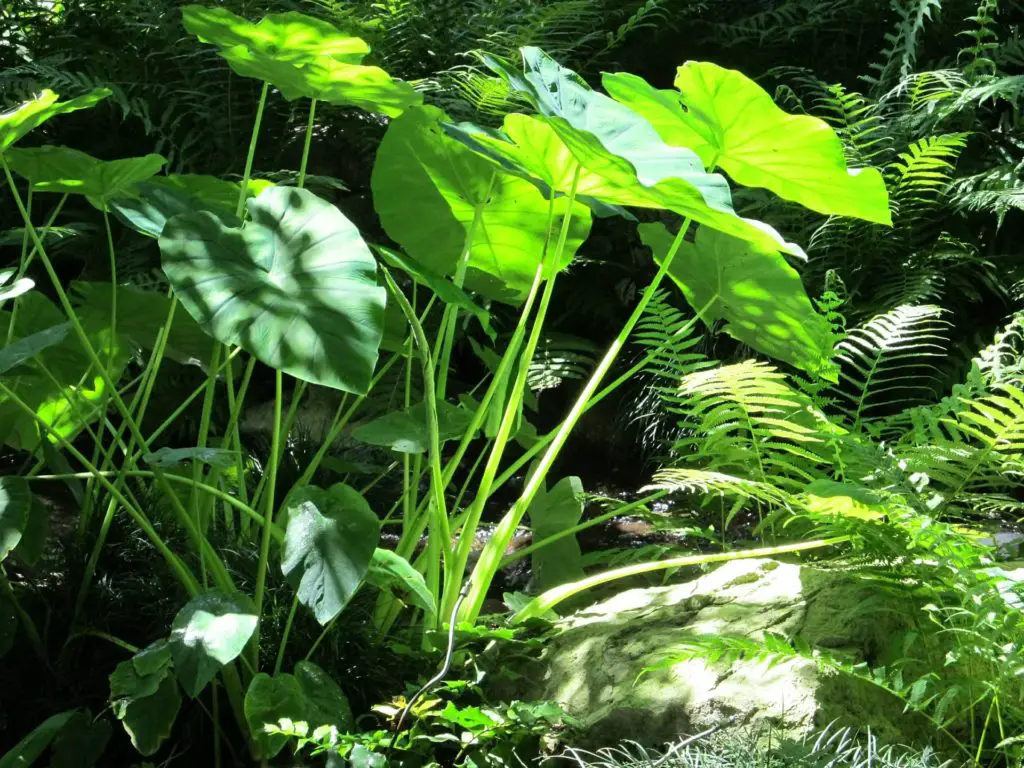The number one factor that will determine either your Elephant ears plant will thrive in your home or yard is the right watering practice. In this article, I will discuss the best practices of watering elephant ear plants. The right water type to use and, how often you should water your elephant ears.
But before diving deep into the details I will put the answer for our main question as simple as this: how to water elephant ears? Water elephant ears deeply until the water drains through the drainage holes. Elephant ears should be watered only one the top two inches of the soil is dry. Keep reading to know the factors that determine how often you should water your elephant ears.

Factors that determine the watering schedule
There are several devices on the internet that recommends watering your elephant ears once or twice a week. But this is not the right way to approach gardening.
Gardening is about understanding the plant’s needs and the environment in which the plant originated. There is no specific schedule for watering elephant ears that will work for everyone because there are factors that differ from one place to another. Those factors are:
Light exposure
Elephant ears thrive best in an environment that gets bright but indirect sunlight. The brightness can differ from one place to another. More the brighter the place the more water elephant ears will consume, And vice versa.
Season
Elephant plant will consume more water during the growing season ( spring and summer). Because in such a season the plant is actively growing. Therefore it consumes more water in order to produce more energy to support the new growth.
While in winter the elephant ears will need less water because it goes dormant. Going dormant means the plant is focusing on resting rather than growth.
So, it is not actively growing in winter. Therefore it does not need high energy to survive. So it consumes a relatively low amount of water.
Indoor or Outdoor
Elephant ears that are living in an indoor environment will need less water when compared with the ones located outdoor. Because the evaporation rate in the indoor environments is way less than in the outdoor environment, especially in summer.
The above are the factors that will determine how often you should water your elephant ears. But you need a concrete rule to guide you. keep reading to get that.
The right way to water elephant ears
Only water your plant when the top two inches of the soil is dry. And when you do, water generously until the water drains from the drainage holes.
Elephant ears love moist but not soggy soil. And by you following such a rule you provide it with what it loves in terms of watering.
Now you know how to water your plant. But there are more important factors that will determine the watering success. Even more important than how often you should water your plant. Those measures are:
Soil
As I mentioned earlier elephant ears love moist but not soggy soil. The potting mix that helps to accomplish that is an all-purpose potting mix.
Such soil is compacted enough to retain moisture. And at the same time, it has enough space between its particles which will help to drain the excess water.
Drainage holes
It is very simple yet it is very important. planting your elephant ears in a planter with enough drainage holes is the first step toward healthy watering.
The drainage holes allow the excess water to drains. If you use a planter without drainage holes, normally the water will accumulate and set in the roots zone for a long period of time. And it will eventually cause root rot.
Root rot is the number one reason for losing houseplants. However, in the next section, I will discuss how to water your elephant ears that planted in a pot without drainage holes.
How to water Elephant ears planted in a pot without drainage holes
Growing elephant ear in a pot without drainage holes is not the right nor the recommended approach. However, many people choose to do so for different reasons.
If you found yourself in a such position. The most critical factor that either will make your plant survive or die is careful watering practice.
In such a case the purpose of watering is to give the plant enough moisture without excessive water. I found the amount of water that accomplishes such an equation is equaled half of the soil volume.
For example, if the soil fills X container. You should water your elephant ears when the top two inches of soil is dry water that fills half the X container.
Which water type you should use
Elephant ears are a tropical plant. That means it gets moisture from rainwater in its natural habitat. Therefore, to have a healthy elephant ear plant that has bigger leaves you should use rainwater.
You can collect rainwater during the autumn season. Then use it throughout the year. The second best water option is purified water in case you don’t have access to rainwater.
Avoid using tap water because tap water contains treated chemicals that will build up through time in the soil as salts. Those salts and minerals will make some important nutrients unavailable for the roots to absorb.
In case you don’t currently have access to both rainwater and purified water. You can use tap water after treating it. You do so by putting tap water in an open container overnight for some treated chemicals to dissipate in the air.
Misting Elephant ears
Elephant ears love humidity. Therefore misting your elephant ears can be great in case it is in a dry environment. But misting can harm your plant if it is in a high humidity location and the evaporation rate is relatively low.
Because of water my set in the leaves and stem for a long period of time which may cause rot. Misting is more effective for outdoor elephant ears plants. And do it in the morning in order for the misted water to evaporate throughout the day.
Overwatered Elephant ears
You can tell whether your elephant ear plant suffering from overwatering by looking at the leaves. Overwatered elephant ear will have leaves with brown dark spots framed with a yellowish rim.
In such a case your plant is suffering from root rot. You need to check the plant’s roots. If you found the roots are soft, mushy, and brown or black in color it is a sure sign that your plant is infected with root rot.
You fix the problem by removing all affected roots by using sterilized scissors. Then wash the remaining roots with water that contains a fungicide. After you did so, allow the roots to dry out.
Then repot your plant in a new potting media. Or use the old potting mix after you treated it. And don’t forget to wash the old pot with soap if you are willing to reuse it.
Underwatered Elephant ears
Elephant ear that is underwatered will have wilting and bending leaves. Also will drop leaves. In such a case water your plant deeply until the water drains through the drainage holes.
Give the soil enough time in order to drains the excessive water. Then you can place it in its decorative pot.
Adujest your watering schedule to achieve our golding rule: “Elephant ear should get deep watering once the top two inches of its soil is dry“.
In Conclusion
In order to have the best elephant ear watering practice, you should use potting soil that holds enough moisture. And at the same time drains the excess water well.
An all-purpose potting mix will achieve that. The second measure you should take is to make sure to plant your elephant ear in a pot with plenty of drainage holes.
Only water your plant when the top two inches of the soil is dry.
